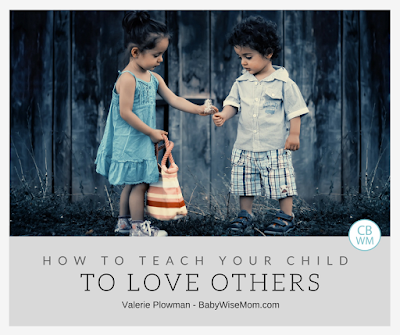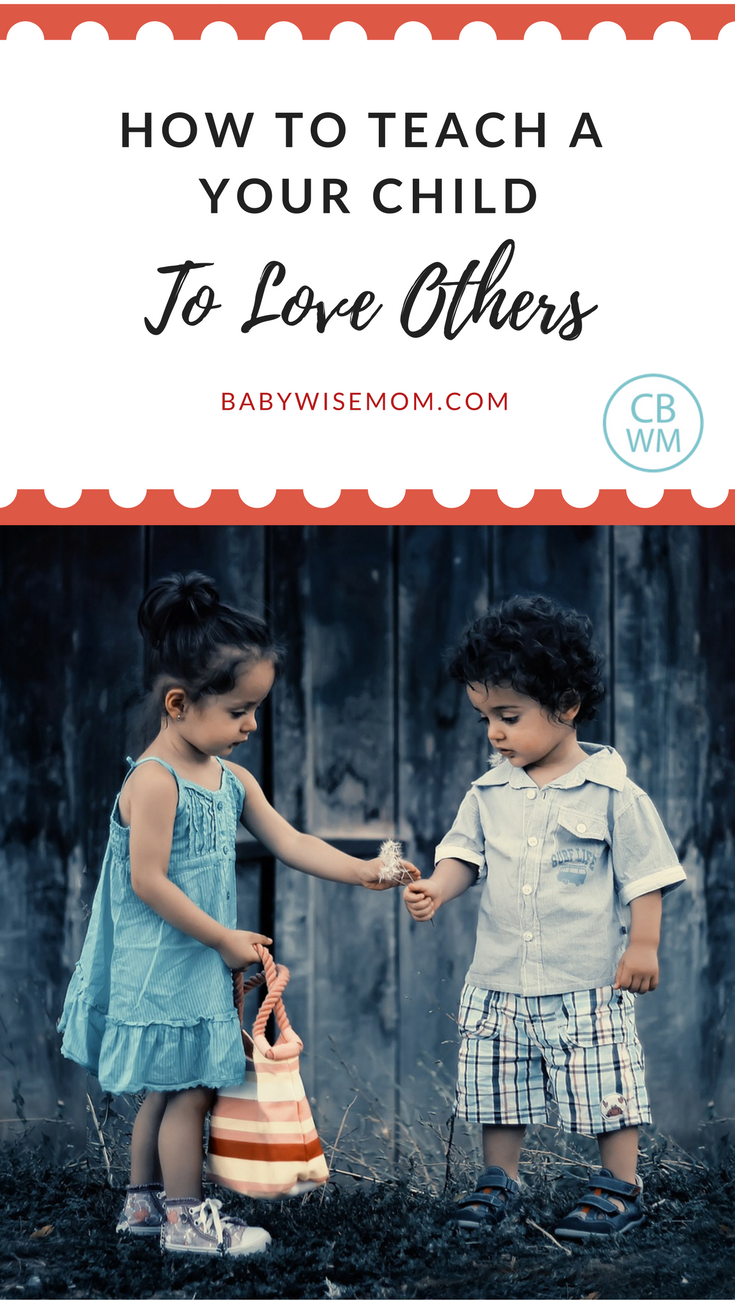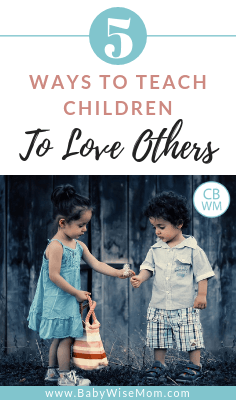How to Teach Your Child to Love Others. Five things you can do to teach your child to have love for others and show that love.
I am not one of those people who thinks children are inherently “bad.” I actually believe children are inherently good. They have numerous qualities that we adults frankly should strive to have ourselves.
Even so, children can be selfish. They literally need to be taught that the world does not revolve around them. While some are naturally loving toward others, most need to be taught and guided to think of others, develop empathy, and love people around them. Sometimes even children who are naturally kind and loving do things that are not kind or loving.
Something I am emphatically not okay with is my children being unkind toward others. I can’t help but think, if my child were on the receiving end of unkindness, how would I hope the mean child’s mother would respond? If my child had no one to play with at recess, I would pray that another child would reach out to mine. If my child were being picked on, I would hope another child would stand up for her. If I would want that for my children on the receiving end, I had better work to be sure they will be that on the giving end.
Post Contents
How to Teach Your Child to Love Others
Here are five ways we teach our children to love others at our house.
Talk, Talk, Talk
There needs to be a conversation in your home of what it looks like to love others. There needs to be a conversation about what your expectations are. There needs to be a conversation about outlining situations and how your child should respond. Your child needs to know the importance of loving others. Matthew 22 talks about loving thy neighbor. This is a literal commandment, and it is our duty as parents to teach that to our children.
In order to have these conversations, time needs to be spent with each other. You need to have meals with each other where conversation happens. You need to chat each day about how school went. When you are driving in the car to soccer practice, talk about things. You need to be willing to listen when your child needs to talk to you, even when your child is two and wants to talk about the rock on the sidewalk. If you want a ten year old to tell you things, you need to listen to that two year old. Otherwise, you have trained that child to believe you are not interested.
Be An Example
“What you do speaks so loudly I can’t hear what you say.” -Ralph Waldo Emerson
In other words, actions speak louder than words.
You cannot tell your child to be kind to others and then you be unkind. You can’t speak poorly of others and expect your child to speak with kindness. You can’t be selfish of your time and self and expect your child to put herself out there. Love your child. Let your child feel what it is like to have love and understanding.
If you are not (or feel like you are not) who you want your child to be, so you can’t be an example, that can change. You can be someone who loves others and shows that to your child. You can! You just need to try. It will come.
Know What is Going On
You need to be plugged in to your child’s life. That is one reason you talk, talk, talk. You need to have a feel for what is happening.
You can’t rely on the talking alone. Your child probably isn’t going to say, “Yeah. I was a total jerk to Tommy today.”
Nope.
You need to know what is going on. You need to let teachers know, “Hey, if my child is not kind toward others, I want to know about it. If you tell me, I won’t yell at you.” Teachers need to know that sort of thing.
You need to trust your instincts when you feel like something is off. Follow up on those feelings.
Serve
Serve others (back to being an example) and teach your children to serve others. Service can be done in the family as well as in the community. Serving others breeds love. If your child is having a hard time loving others or a certain other, add service into life. When you serve people, you love them.
Quickly Correct
If and when the day comes you find out your child didn’t show love, be quick to correct it. Do so with kindness and love. Yelling at your child about not loving others just doesn’t quite send the right message.
When your child talks about the “weird kid” at school, don’t chuckle along. Gently help your child learn to see life through the “weird kid’s” point of view. Talk about how the “weird kid” must feel having everyone label him as “weird.”
Example of My Children Loving Others
When Brayden was in second grade, he found a boy crying at recess. Brayden asked the boy what was wrong, and the boy replied no one would play with him. Brayden said he would play, and to this day, they are still super close friends.
One day, Kaitlyn came home all upset because of a way a girl was acting at school. I was able to talk with her about trying to understand why this girl might have been acting this way and see things from the other girl’s perspective. She was new to the school and probably felt this was the way she needed to act to gain some friends. Kaitlyn took a step back and decided the girl was probably not so mean after all. She worked on some empathy.
One day at dinner, we talked about the importance of making sure everyone had a friend to play with at recess. The next day, McKenna started inviting a new girl to join her friends at recess. Her friends were welcoming and this girl had a group of friends to play with.
One day when I was helping in Brinley’s class, a little girl was copying everything Brinley did. She colored her animals the same way Brinley did. She even cut them out in the exact same order. A different little girl said, “Brinley! She is copying you!” Brinley replied, “That’s okay. If someone copies you, it just means they like you.” I was so glad she responded with patience and love. Then she went on, “My mom says when someone copies you, they do it because they love you.” A couple of days earlier, McKenna had been copying everything Brinley did and said. When Brinley was upset by that, I simply told her, “That’s okay! It just means she likes you.” I was so glad I had, in a simple moment, taught her to have patience for someone copying you and to look at it as a compliment instead of telling McKenna to stop being annoying.
Those are some positive examples, now for how I handle when the negative happens.
I once had a feeling something was off between Kaitlyn a certain one of her friends. I asked her and she said everything was fine. I asked multiple times over a couple of weeks. She insisted everything was fine. I ran into the friend at school one day, and I could just tell by her body language and non-verbals that everything was not okay (there isn’t anything specific she did; my minor is in communications and I took entire classes on non-verbal communication, so I have studied how to read people).
I investigated more and found things were not fine. Certain girls had decided another girl was not a “friend” and Kaitlyn was doing nothing to interfere. Basically, my assessment was that “mean girl” activity was going on, Kaitlyn was on the mean girl side of it, and I was NOT okay with that. Kaitlyn and I talked calmly about it (I didn’t WANT to talk calmly initially. I wanted to give her a nice lecture on why that wasn’t okay. However, I am logical and that isn’t the effective way to communicate with your child, especially a preteen, and I got myself in a nice place before talking to her).
We had a great conversation. I focused on the feelings of the other girl, and how would Kaitlyn feel if she were on the other side of it. We talked about loving others no matter what. We talked about standing up for others. We talked about how she could kindly impact everyone to be nice to each other (Kaitlyn is not confrontational, so it is hard for her to stand up to people–but it can be done in a non-confrontational way). At the end of the conversation, Kaitlyn decided she needed to apologize and make things right with her friend. Let me share a message she wrote to me afterwards (Kaitlyn loves to write notes).
“Hey Mom! I sent that letter to [my friend ] about being sorry. I really, after I wrote that letter I realized that every fight we have ever gotten in was my fault!! I know that I wasn’t being that smart now. I believe that Heavenly Father and Jesus Christ had you tell me about that. I feel like a huge weight has been lifted off my shoulders now, that I never knew was there! I love you! Thank you so much for talking to me about that!!”I responded: “I love you sweetie! I am so glad you are humble and willing to take instructions and correction. I sure love you! I am proud of you for apologizing.”Kaitlyn replied: “Thanks, Mom!!!!!!!!!!! I am really happy that you are so nice to me!”
I mean. Children are inherently good. They don’t want to be unkind or unloving toward others, but they are human and sometimes are. When we lovingly guide them and correct them, they are grateful for that. They are relieved. They are happy to know mom and dad expect goodness from them. I am also happy to report that since that talk, everything is good and everyone is getting along. Loving others is powerful, and when we help our children to learn to feel and show love for others, they can be such a force for good among their peers and friends. The world needs more tolerance, love, and kindness. Let’s be the parents that help facilitate that.
Check out these posts today from other Babywise blogging mamas!
- How To Have A Happy Marriage When You Have Small Children
- Showing Love to the Expectant Mother during Adoption
- My Daughter- What I Want You To Know About Valentine’s Day
- Teaching Your Children Valentine’s Day Is More Than Just Romance




